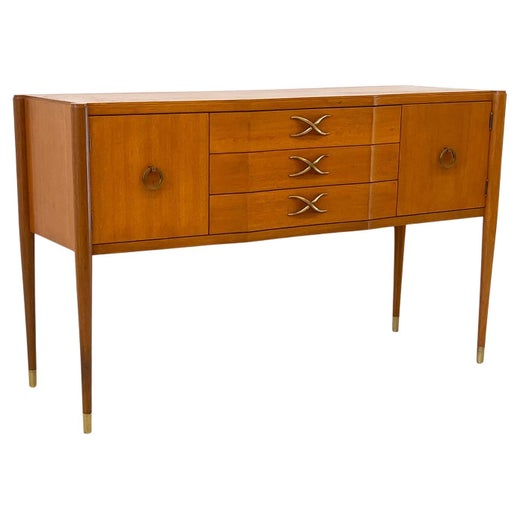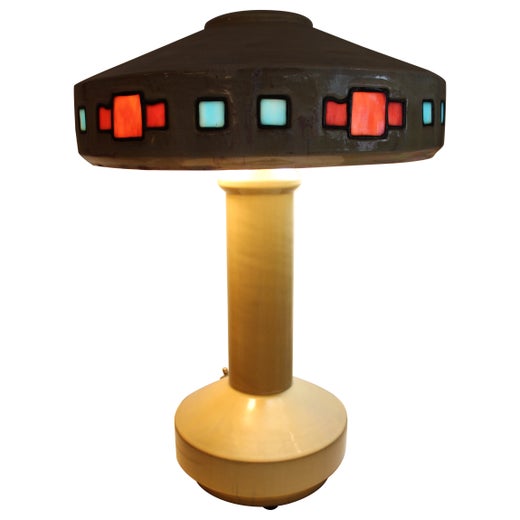1928 Fulper Stangl Paul Frankl Skyscraper Cigarette / Match Box R. Rosenthal
About the Item
- Creator:Paul Frankl (Designer),Fulper Pottery (Manufacturer)
- Dimensions:Height: 2.88 in (7.32 cm)Width: 3.38 in (8.59 cm)Depth: 1.88 in (4.78 cm)
- Style:Art Deco (Of the Period)
- Materials and Techniques:Ceramic,Glazed
- Place of Origin:
- Period:
- Date of Manufacture:circa 1928-1929
- Condition:Wear consistent with age and use. Minor losses. Minor structural damages.
- Seller Location:Dallas, TX
- Reference Number:1stDibs: LU94529970493
Paul Frankl
Born in Vienna, Paul Frankl came to the United States in 1914 as part of a wave of Central European design luminaries — among them Kem Weber, Rudolph Schindler, and Richard Neutra — who were drawn by the energy and optimism of the American scene. Prolific and protean, Frankl would go on to design furnishings that are emblematic of nearly every key stylistic chord in American modernism, from the streamlined Art Deco to free-form organic shapes.
Frankl's Skyscraper cabinets, bookcases and more — introduced in 1924 — are his earliest and best-known designs (and the work by which he is most often represented in institutions, such as New York’s Metropolitan Museum of Art). Tall and narrow, the pieces have staggered shelves meant to mimic the setbacks of Manhattan office towers. A later visually expressive line — the Speed chairs and sofas, which have a raked profile suggesting motion — links Frankl to Donald Deskey, Raymond Loewy and other creators of Streamline Moderne design.
Frankl moved to Los Angeles in 1934 and luxuriated in the climate and lifestyle. His designs became lighter and simpler and found an audience among the Hollywood élite. (Katharine Hepburn, Cary Grant and Fred Astaire were clients.) Fascinated by Asian arts, Frankl produced numerous pieces — tabletops with edges that curve upward; sofas, chairs and other seating with rattan frames — inspired by Chinese and Japanese forms and materials. In the 1940s, Frankl became one of the first designers to incorporate free-form, biomorphic shapes in his work, as well as novel upholstery fabrics such as denim and nubby wool.
Frankl biographer Christopher Long argues that the designer’s easy, elegant aesthetic had an enormous influence on movie set design. As the furniture below attests, Paul Frankl’s work is ready for its close-up.
Find vintage Paul Frankl tables, dining chairs, case pieces and storage cabinets on 1stDibs.
Fulper Pottery
Best known for its stylish Vasekraft line, Fulper Pottery was a major producer of American art pottery, which grew out of the Arts and Crafts movement in the United States.
Like the Rookwood, Roseville and Van Briggle potteries, the Flemington, New Jersey–based Fulper flourished from the 1870s through the 1920s. During that period, U.S. consumers favored the fluid forms and cool color palette of Art Nouveau ceramics, as well as the practicality of the Craftsman style.
Unlike studio ceramics, in which each piece is hand thrown on a potter’s wheel, most art pottery — including vintage Fulper vases, bowls and other creations — was made using molds, yielding identical forms that were glazed in distinctive patterns like the butterscotch and cat’s-eye combination displayed in this 1915 example.
The company that became Fulper Pottery was founded in 1841. Initially a manufacturer of utilitarian ceramics ranging from crockery to drain pipes, it was bought in 1960 by Abram Fulper, who changed its name from Samuel Hill Pottery and retooled it to make more refined ceramics using the region’s red clay.
Incorporated as Fulper Pottery Co. in 1899 under the leadership of Abram’s two sons, it produced attractive utilitarian householdware such as its line of fireproof cookware and its Germ-Proof Filter, a sort of early water cooler used in public places.
The firm made its first forays into art pottery with a line of glazed vessels created by its master potter, John Kunsman, pieces from which were shown at the 1904 Louisiana Purchase Exposition and won an honorable mention. At that time, a series of World’s Fairs and museum shows were fueling a fascination among the public with East Asian art and design. In response, the American art pottery community began producing wares with glazes that recalled the brilliant colors and shimmering surfaces of Chinese ceramics. Fulper’s entry was its Vasekraft line, which launched in 1909.
Unfortunately, the original glazes employed were not entirely successful and, even more importantly, were expensive to produce.
In the 1910s, Fulper’s new ceramic engineer, Martin Stangl, revamped the Vasekraft line with glazes less like the Chinese and more akin to those of Roseville and Rookwood pottery, with more uniform coloration and matte surfaces. His designs ranged from bookends to candle holders, desk accessories, and lamps, all of which remained popular into the 1920s.
Following World War I, Fulper introduced new lines, such as Fulper Pottery Artware and Fulper Porcelaines, which were marketed specifically to women and featured delicate items for a fashionable dressing table, as well as a solid-color Fulper Fayence. After William Fulper’s death, in 1928, Stangl was named president, and in 1935 the Stangl Pottery line became the company’s only product. In 1978, Fulper was purchased by Pfaltzgraff.
Find vintage Fulper pottery for sale on 1stDibs.
You May Also Like
Vintage 1930s American Art Deco Vases
Clay
Vintage 1970s German Modern Games
Porcelain, Wood
Vintage 1970s Italian Post-Modern Toys and Dolls
Ceramic
Vintage 1930s Italian Art Deco Ceramics
Ceramic
Vintage 1960s British Sterling Silver
Sterling Silver
Antique Late 19th Century Austrian Tobacco Accessories
Sterling Silver
Vintage 1930s German Art Deco Ceramics
Ceramic
Mid-20th Century Asian Chinoiserie Ashtrays
Brass, Enamel
Mid-20th Century Italian Mid-Century Modern Ceramics
Porcelain
Mid-20th Century Italian Mid-Century Modern Ceramics
Metal

